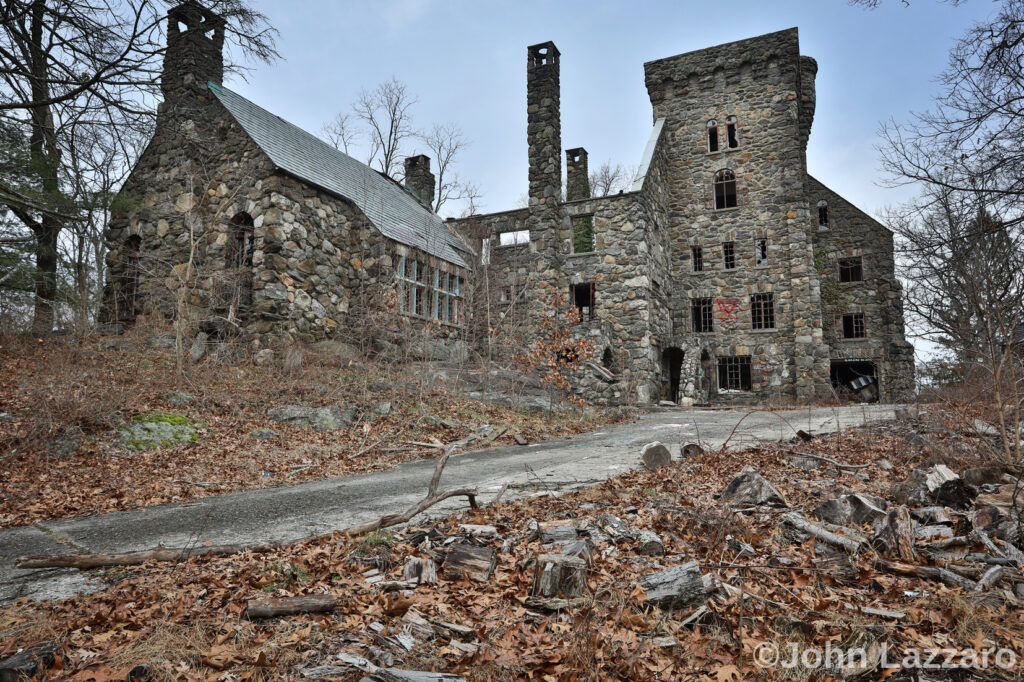
Nestled off the trails of the Sunny Ridge Preserve in Ossining, New York, lie the remains of the ‘ELDA’ estate. This castle-like mansion built in 1925 once belonged to David Abercrombie, founder of the renowned clothing brand Abercrombie & Fitch. Since 2017, ELDA has been on the market while nature and vandals slowly overtake the once vibrant and historic estate.

Before his career in the clothing industry brought him international fame, David Abercrombie studied engineering at the Maryland Institute College of Art (MICA). After graduating in 1885, he served as a land surveyor and civil engineer for the Baltimore & Ohio and various other railroad companies. During that time he mapped and surveyed previously undocumented regions of the Appalachian Mountains ranging from North Carolina to Kentucky.
To withstand the rugged terrain of the region, Abercrombie designed his own camping gear and outdoor wear. After being forced into premature retirement due to farsightedness, Abercrombie used his ingenuity and talent to open his own retail store – The David T. Abercrombie Company. His first store opened in 1892 on South Street in Manhattan. Inside, he sold premium outdoor sporting products, fishing and camping gear, hunting rifles, and specialized clothing featuring many of his own designs.
One of the most loyal customers frequenting the store was a lawyer named Ezra Fitch. Fitch would eventually leave his practice to join Abercrombie as a business partner. In 1904, the store officially became the Abercrombie & Fitch Company, but their business relationship soon turned into a battle over the future direction of their clothing company. David wanted the store to remain true to an outdoor outfitter, but Ezra called for a more generalized retail store, catering to a larger clientele. By 1907, a mere three years after becoming official partners, David Abercrombie sold his share to Fitch and “disposed of all his interest” in the company.

After he split from the company, David Abercrombie continued to work in the manufacturing business and served briefly in WWI as a Major in the Quartermaster Reserve Corps, helping to outfit troops overseas. Having been semi-retired by the mid-1920s, David Abercrombie and his wife, Lucy Abbott Cate, purchased 60 acres of land in the town of Ossining – a popular real estate venue for prominent New Yorkers. Their residence was constructed from 1925 to 1927 and then given the name ‘ELDA,’ an acronym for each of their four children – Elizabeth, Lucy, David, and Abbott.
ELDA was an English Cottage-style mansion built of steel derived from Abercrombie’s father’s ironworks in Baltimore, and locally sourced granite and fieldstone. The architect is unknown but it is strongly believed that Abercrombie’s experience as a land surveyor came into play during ELDA’s construction. The home consisted of twenty-five rooms with servant’s quarters, four sections with intersecting gables, and a section with a hipped roof.

The formal living room boasted exposed wood beams, a fireplace, and a tiled floor, alluding to a ‘great hall’ in a medieval castle. A flight of curving stone steps led to the main entrance. From there, guests entered a glass vestibule which served as a conservatory for Mrs. Abercrombie’s plants. A set of iron spiral steps within the vestibule led to a lookout tower that afforded views of the Hudson River. Other unique features of ELDA included a sleeping porch, a living room with a dumbwaiter, a three-car garage, and a gun room where David displayed his collection of antique hunting rifles. Surrounding the property were three guest residences, a bathhouse, a swimming pool, and a large pond.



After a long bout against rheumatic fever, David Abercrombie passed away on August 29, 1937. Lucy Abbott Cate soon moved to New Jersey to live with her daughter, Elizabeth, leaving ELDA unoccupied for several years until it was sold to a private firm in the 1940s. In 1964, Harrick Scientific Company President James Harrick purchased ELDA for $15,000 and began to renovate the dilapidated estate. This venture ultimately proved to be too costly and frustrating. The estate then sold to Corliss Lamont, Ph.D., and his wife, Beth, for $1.51 million in 2001. An attempt to turn ELDA into a conference and retreat center called “Half Moon Foundation Castle,” was unsuccessful. ELDA would go through a few more owners before being abandoned around 2012.


